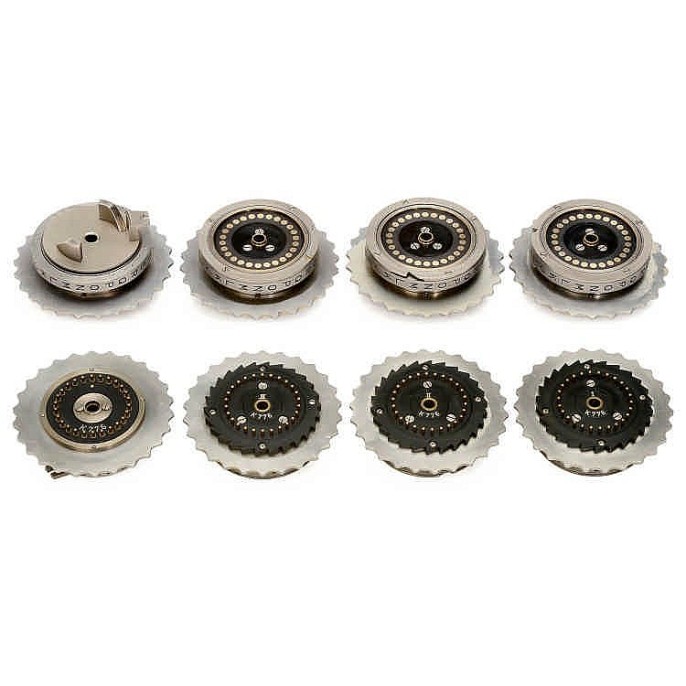[Enigma is] the legendary World War II ciphering machine developed by Berlin engineer Dr. Arthur Scherbius and first manufactured there commercially by the Chiffriermaschinen Aktiengesellschaft [Cipher Machines Corporation] Berlin in 1923. So complex was the Enigma, it was considered capable of producing over 22 billion code combinations without a single repetition. According to an early prospectus, ‘if someone worked continuously day and night and tried a different cipher-key every minute, it would take 42,000 years to exhaust all combination possibilities.‘
In operation, each keystroke illuminated a different character and caused one or more rotors to shift fractionally, so that a different combination was created every time. Decryption required codebooks and a list of daily key settings.
How Enigma was finally figured out – and its messages decoded by the Allies – is a storied affair. It began in 1938 with Polish Cipher Bureau cryptologist Marian Rejewski developing his bomba kryptologiczna (Polish for cryptologic bomb). Due to the ‘deteriorating political situation,’ Rejewski and the Poles shared the Enigma-breaking techniques and equipment with the French and British in July 1939. Alan Turing then produced the initial design of the bombe at the UK Government Code and Cypher School (GC&CS) at Bletchley Park. Turing’s original design, while brilliant in theory, presented a major impracticality in the physical realm. This was solved in 1940 when Gordon Welchman devised an important design refinement, the ‘diagonal board’, that rendered the device substantially more efficient in the attack on ciphers generated by the German Enigma machine. The engineering design and construction was the work of Harold Keen of the British Tabulating Machine Company. If you are interested in the details of The Turing Bombe you’ll find a wealth of info here.

The Bombe Front and Back. Designed by Alan Turing. Bombe took the form of emulating several hundred Enigma rotors, as well as functioning as a logical electrical circuit to automate the deductions needed to rule out flawed possible attempts. (Photo by Peter Oram)
That’s a lot of computing power and a lot of machine. It emphasizes the incredible cryptologic power of Enigma itself. Wikipedia’s entry on this fascinating machine is quite thorough, click here to learn more about its design and operation, as well as a host of other interesting info. A point well made at Wikipedia is this:
Though Enigma had some cryptographic weaknesses, in practice it was German procedural flaws, operator mistakes, failure to systematically introduce changes in encipherment procedures, and Allied capture of key tables and hardware that, during the war, enabled Allied cryptologists to succeed.
There is beauty in simplicity. Below are some pics of an Enigma K-Model machine, manufactured by Chiffriermaschinen-Ges. Heimsoeth und Rinke, Berlin, c. 1939. Looking at it one would not expect it to be such a robust mystery machine.

4-Rotor Ciphering Machine Enigma K-Model set, with an external lamp panel and a separate power supply in an oak case.

Enigma K-Model set, with uplifted covers showing the minimal rotor, key, and external lamp panel design.

This type of machine, devised by the German Navy in 1939, was used to encode wartime messages requiring a particularly high degree of security. The capture of German U-boat U-110 on May 9, 1941 in the North Atlantic by the Royal Navy played a key role in the outcome of the North Atlantic U-boat engagements. The Royal Navy had recovered an Enigma machine, its cipher keys, and code books. The recovered materials were taken to Bletchley Park in England, where cryptographers, including computer pioneer Alan Turing, succeeded in breaking the naval code. The codes allowed the U-boat traffic to be read for several weeks, until the keys ran out. (Photo by SSPL/Getty Images)
As can be imagined, history and tech buffs would probably love to get their hands on one of these extraordinary and significant machines. On May 30, 2015, at 10:00 AM CET, someone has an opportunity to do so. Auction Team Breker, in Köln, (Godorf), Germany, have two Enigma machines that will be up for auction on that day. An Enigma M4 Cypher Machine, c. 1942, and an Enigma K-Model, c. 1939. Both are in pristine museum-quality condition. The starting bid for the M4 is €26,000. The starting bid for the K-Model (shown above) is €10,000. Although it is a live auction, bids are being taken now at the Invaluable on-line auction site.
For the rest of us who don’t have thousands to spend on rarities such as this, there are a number of Enigma computer simulations to play with. A few of them are listed below.
- Enigma Simulator for Mac OS X (Terry Long)
- Enigma Simulator for Windows (Dirk Rijmenants)
- Crypto Simulation Group (Windows)
- Arduino Enigma
- Enigma Simulator for RISC OS
- JavaScript Simulator for Enigma I, M3, M4 and Abwehr (works with all browsers)
- Enigma Java Applet (Andy Carlson)
- Java Applet of the Enigma-G (Anton Haddeman)
- Simple Java Applet of 3-wheel Enigma (James Brunskill)
- Enigma Simulator in Macromedia Flash
- Enigma-E, electronic self build kit





